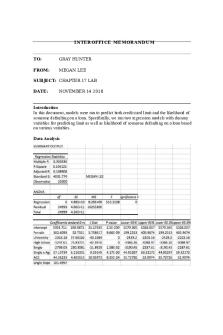Memo Outline Lab-4-3 - Regression Models with Dummy Variables Lab PDF

| Title | Memo Outline Lab-4-3 - Regression Models with Dummy Variables Lab |
|---|---|
| Course | Analytical Methods for Business |
| Institution | University of Arizona |
| Pages | 3 |
| File Size | 281.4 KB |
| File Type | |
| Total Downloads | 57 |
| Total Views | 132 |
Summary
Regression Models with Dummy Variables Lab...
Description
INTERO FFICE MEMORAN DUM
TO:
GRAY HUNTER
FROM:
MEGAN LEE
SUBJECT: CHAPTER 17 LAB DATE:
NOVEMBER 14 2018
Introduction In this document, models were ran to predict both credit card limit and the likelihood of someone defaulting on a loan. Specifically, we ran two regression models with dummy variables for predicting limit as well as likelihood of someone defaulting on a loan based on various variables. Data Analysis
Regression equation: ^ Credit Limit=−22.94 +302.61 ( female ) +921.43 ( university )+3237.61 ( grad school ) +2930.03 ( married )−5 Interpretation of R-squared: We are 10.91% of the way to perfectly predicting credit limit using the variables in the model. Interpretation of coefficients: Since all of the variables have low p-values, we can conclude that all explanatory variables can be used. Females will have a $302 higher credit limit than men, on average all else constant. As age increases by 1 for single people, credit limit increases by $101.50, on average all else constant. As age increases by 1 for married people, credit limit increases by $44.36, on average all else constant. As age increase by 1 for single people, credit limit increases $57.14 more than for a married person. Predict limit of a 35-year-old, married, female with a university degree: -22.94 + 302.61(1) + 921.43(1) + 3237.61(0) + 2930.03(1) – 57.14(35*1) +101.50(35) = $5683.73
^ likelihood of defaulting = .208+0.00000448(Average bill amount) – 0.00014(average previous payment amount + 0.000831(age) Interpretation of R-squared:
2
We are 11.25% of the way to perfectly predicting someone’s probability of defaulting on a payment using the variables in the model. Interpretations of coefficients: As average bill amount increases by $100, the chance of defaulting increase by .0448 percentage points, on average all else constant. As age increases by 1, likelihood of defaulting increases by .0831 percentage points, on average all else constant. Predict the chance of someone defaulting who is 40 years old, has an average bill amount of $1500, and average payments of $700: .208 + 0.00000448(1500) – 0.00014(700) +0.000831(40) = 0.14996 There is a 15% chance that someone who is 40 years old with an average bill amount of $1500 and average previous payments of $700 will default on their payment. Conclusion Two regression models were ran two with dummy variables for predicting limit as well as likelihood of someone defaulting on a loan based on various variables. Because of both of their low R-square, I would not suggest using either of these models.
3...
Similar Free PDFs

Variables dummy de estadistica
- 4 Pages

Dynamic Regression Models
- 5 Pages

dummy
- 17 Pages

Kernel regression estimation with np
- 12 Pages

Binary Logistic Regression with SPSS
- 29 Pages

Tail Hedging Flirting with Models
- 17 Pages

Molecular Models Pre-Lab
- 1 Pages

Memo - Memo
- 2 Pages
Popular Institutions
- Tinajero National High School - Annex
- Politeknik Caltex Riau
- Yokohama City University
- SGT University
- University of Al-Qadisiyah
- Divine Word College of Vigan
- Techniek College Rotterdam
- Universidade de Santiago
- Universiti Teknologi MARA Cawangan Johor Kampus Pasir Gudang
- Poltekkes Kemenkes Yogyakarta
- Baguio City National High School
- Colegio san marcos
- preparatoria uno
- Centro de Bachillerato Tecnológico Industrial y de Servicios No. 107
- Dalian Maritime University
- Quang Trung Secondary School
- Colegio Tecnológico en Informática
- Corporación Regional de Educación Superior
- Grupo CEDVA
- Dar Al Uloom University
- Centro de Estudios Preuniversitarios de la Universidad Nacional de Ingeniería
- 上智大学
- Aakash International School, Nuna Majara
- San Felipe Neri Catholic School
- Kang Chiao International School - New Taipei City
- Misamis Occidental National High School
- Institución Educativa Escuela Normal Juan Ladrilleros
- Kolehiyo ng Pantukan
- Batanes State College
- Instituto Continental
- Sekolah Menengah Kejuruan Kesehatan Kaltara (Tarakan)
- Colegio de La Inmaculada Concepcion - Cebu







